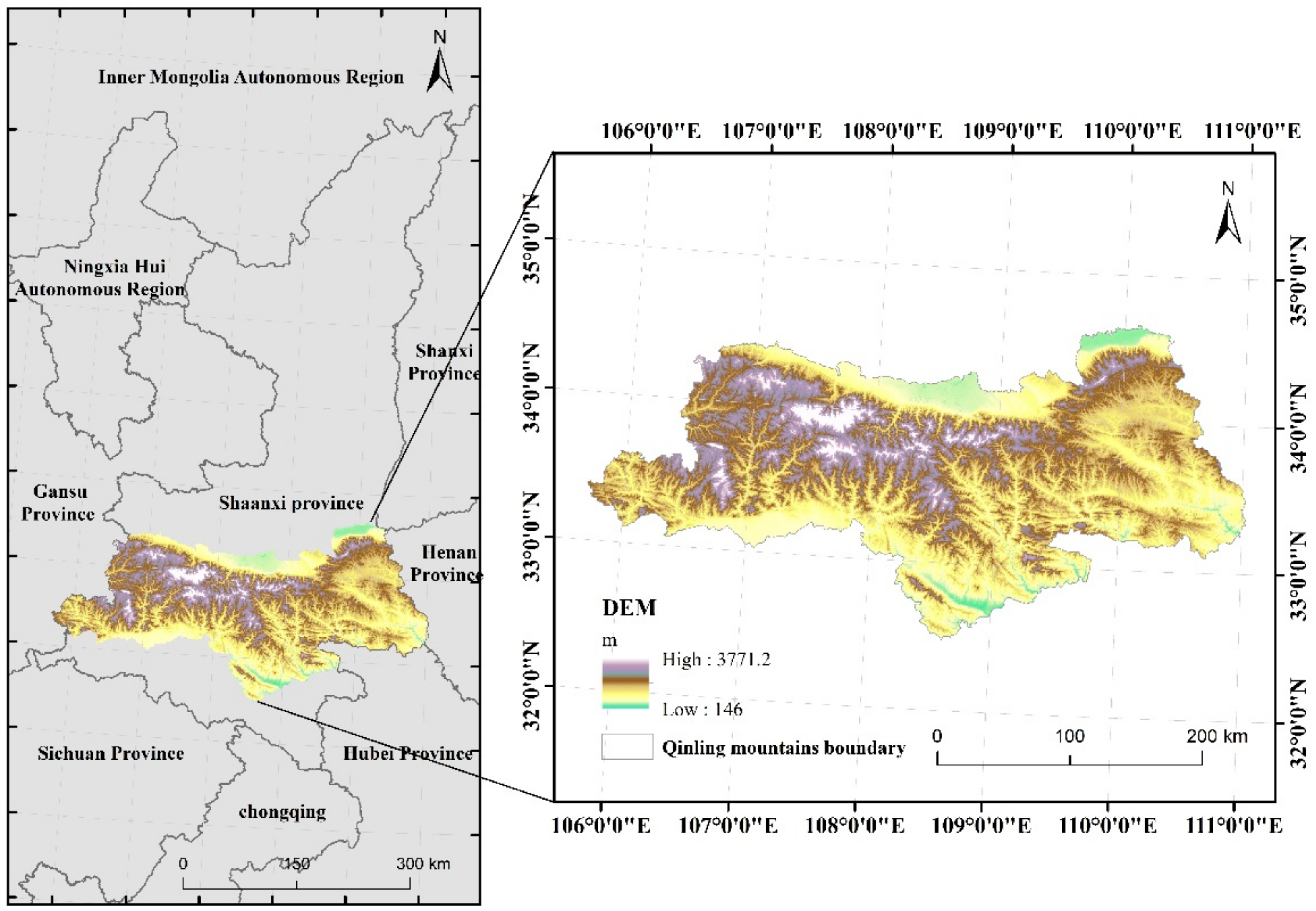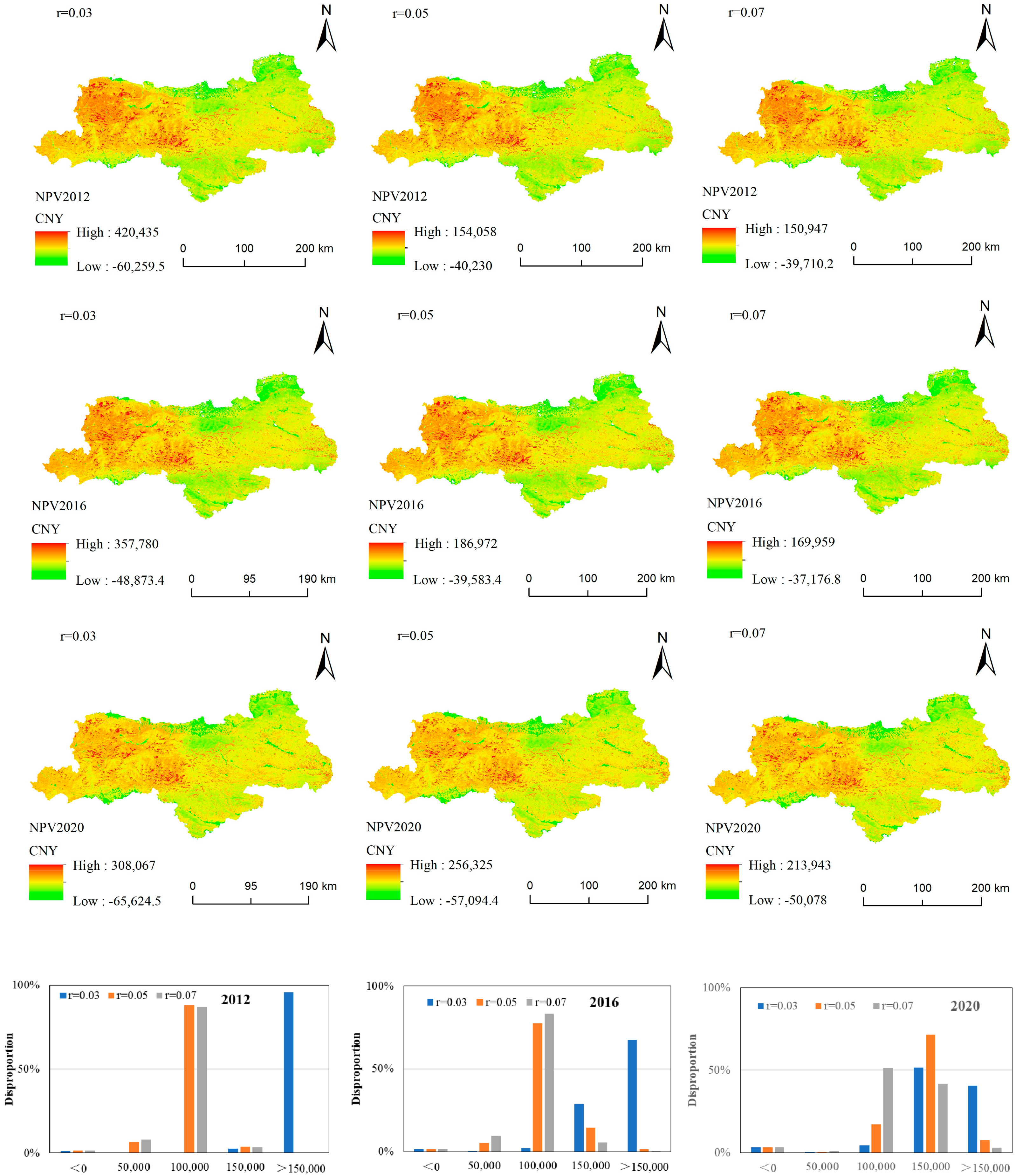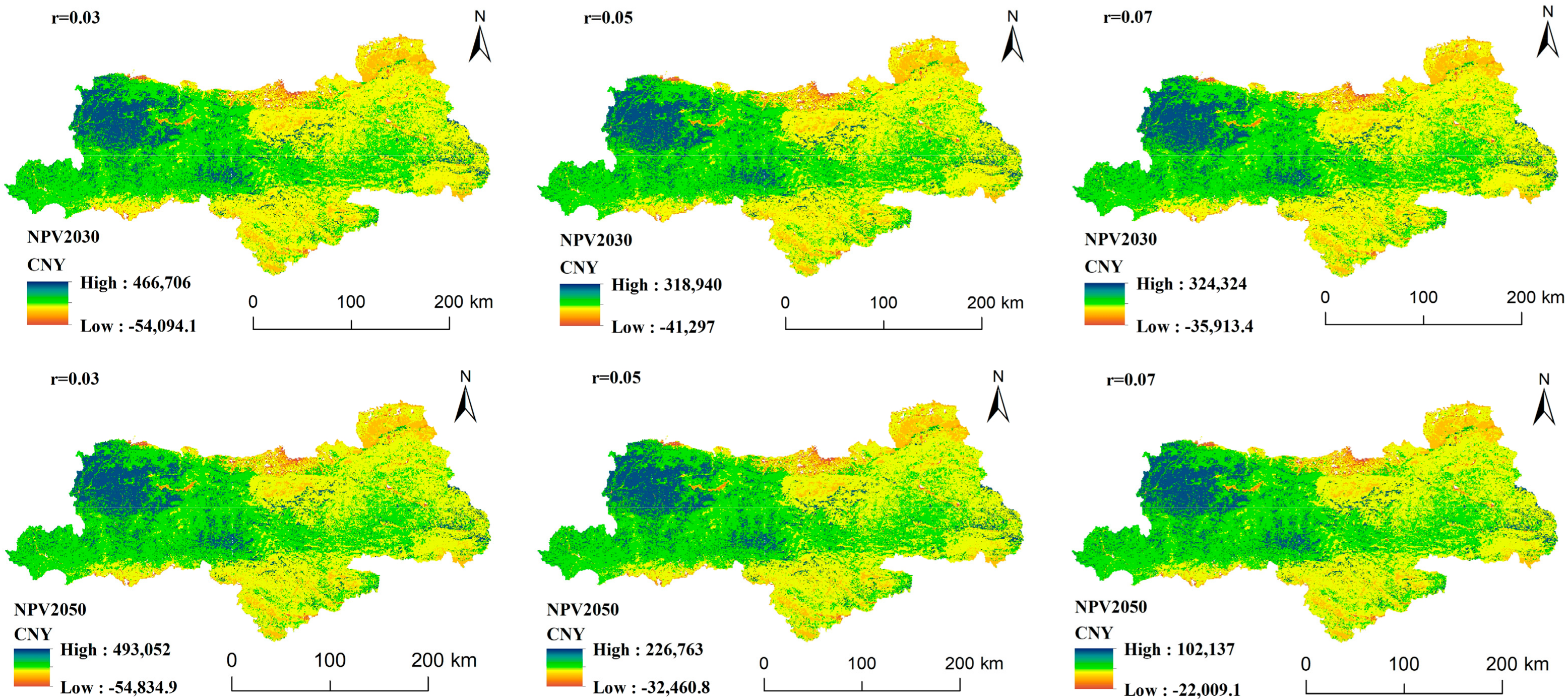Simulation of Spatial Service Range and Value of Carbon Sink Based on Intelligent Urban Ecosystem Management System and Net Present Value Models—An Example from the Qinling Mountains
Abstract
:1. Introduction
2. Materials and Methods
2.1. Overview of the Study Area
2.2. Data Source
2.3. Methods
2.3.1. IUEMS Model
2.3.2. Calculation and Simulation of Carbon Emissions
2.3.3. Calculation of Carbon Sequestration Service Scope
2.3.4. PLUS Model
2.3.5. NPV (Net Present Value) Model
3. Results
3.1. Temporal and Spatial Distribution of Carbon Sequestration in the Qinling Mountains
3.2. Spatial and Temporal Distribution of Carbon Emissions and Calculation of Carbon Neutral Spatial Service Range in Qinling Mountains
3.2.1. Spatial and Temporal Distribution of Carbon Emissions
3.2.2. Calculation of Carbon Neutral Space Service Scope in Qinling Mountains
3.2.3. Future Carbon Neutrality Spatiotemporal Simulation and Its Spatial Service Scope
3.3. Spatial and Temporal Distribution of Carbon Sink Value Accounting
4. Discussion
5. Conclusions
Author Contributions
Funding
Institutional Review Board Statement
Data Availability Statement
Conflicts of Interest
References
- Zhou, J.; Su, H.J.; Wu, Q. China EU inter organization cooperative research project mix-up helps to achieve “carbon neutrality”. J. Biosci. Bioeng. 2021, 37, 1–11. [Google Scholar]
- Department of Industry and Information Technology of Yunnan Province, Department of Ecological Environment of Yunnan Province, Development Plan of Environmental Protection Industry in the 14th Five Year Plan of Yunnan Province. Available online: http://www.atcrr.org/show-20-8556-1.html (accessed on 1 July 2021).
- Muradov, N.Z.; Veziroglu, T.N. “Green” path from fossil-based to hydrogen economy: An overview of carbon-neutral technologies. Int. J. Hydrogen Energy 2008, 33, 6804–6839. [Google Scholar] [CrossRef]
- Butterman, H.C.; Castaldi, M.J. CO2 as a carbon neutral fuel source via enhanced biomass gasification. Environ. Sci. Technol. 2009, 43, 9030–9037. [Google Scholar] [CrossRef]
- Wrke, M.; Smith, B.; Remme, U. Nordic Energy Technology Perspectives: Pathways to a Carbon Neutral Energy Future; Smith, M., Ed.; OECD/IEA: Paris, France, 2013; Volume 4, pp. 255–297. [Google Scholar]
- Pearson, R.J.; Eisaman, M.D.; Turner, J.W.G.; Edwards, P.P.; Jiang, Z.; Kuznetsov, V.L.; Littau, K.A.; di Marco, L.; Taylor, S.R.G. Energy Storage via Carbon-Neutral Fuels Made From CO2, Water, and Renewable Energy. Proc. IEEE 2011, 100, 440–460. [Google Scholar] [CrossRef]
- Kennedy, C.; Bristow, D.; Derrible, S.; Mohareb, E.; Saneinejad, S.; Stupka, R.; Sugar, L.; Zizzo, R.; Mcintyra, B. Getting to Carbon Neutral: A Review of Best Practices in Infrastructure Strategy; Bose, R.K., Ed.; The International Bank for Reconstruction and Development: Washington, DC, USA, 2010; Volume 4, pp. 165–184. [Google Scholar]
- Syj, A.; Js, A.; Yu, J.; Lim, S.H.; Lee, J.Y.; Yoo, J.I.; Park, S.Y.; Na, J.; Park, S.J. A shortcut to carbon-neutral bioplastic production: Recent advances in microbial production of polyhydroxyalkanoates from C1 resources. Int. J. Biol. Macromol. 2021, 192, 978–998. [Google Scholar]
- Bartolini, A.; Salvi, D.; Pelagalli, L.; Caresana, F.; Comodi, G. Technological options towards a carbon neutral town in central Italy. In Proceedings of the E3S Web of Conference 2021, Ljubljana, Slovenia, 19 April 2021. [Google Scholar]
- Chen, X.; Liu, Y.; Wang, Q.; Lv, J.J.; Wen, J.Y.; Chen, X.; Kang, C.Q.; Cheng, S.J.; Michael, B.M. Pathway toward carbon-neutral electrical systems in China by mid-century with negative CO2 abatement costs informed by high-resolution modeling. Joule 2021, 10, 2715–2741. [Google Scholar] [CrossRef]
- Badole, S.; Roy, D.; Singh, L.K. Carbon Neutral Roadmap for Green India; New India Publisher Agency: New Delhi, India, 2021; Volume 3, pp. 191–222. [Google Scholar]
- Ding, Z.L.; Duan, X.N.; Ge, Q.S. Evaluation of international greenhouse gas emission reduction schemes and Discussion on China’s long-term emission rights. Sci. China Earth Sci. 2009, 39, 1659–1671. [Google Scholar]
- Guo, C.Z.; Wu, Y.Y.; Ni, J. Estimation of vegetation carbon storage in Tiantong National Forest Park. J. Appl. Ecol. 2014, 25, 3099–3109. [Google Scholar]
- Liu, Y.; Duan, M.; Zhao, Y.J. Study on decomposition of influencing factors of CO2 emission from China’s iron and steel industry based on LMDI method. Safe Environ. Eng. 2016, 23, 6–11. [Google Scholar]
- Fu, C.; Yu, G.R.; Fang, H.J. Impact of regional land use/Cover Change on land carbon budget in China. Program Geosci. 2012, 31, 88–96. [Google Scholar]
- Gatzsche, K.; Babel, W.; Falge, E.; Pyles, R.D.; Paw U, K.T.; Raabe, A.; Foken, T. Footprint-weighted tile approach for a spruce forest and a nearby patchy clearing using the ACASA model. Biogeosciences 2018, 15, 2945–2960. [Google Scholar] [CrossRef]
- Zhang, X.L.; Xiao, W.H.; Wang, Y.C. Temporal and spatial characteristics of NPP and climate driving mechanism in the Three Gorges Reservoir Area Based on the improved CASA model. J. Ecol. 2021, 41, 3488–3498. [Google Scholar]
- Hidy, D.; Barcza, Z.; Haszpra, L.; Churkin, G.; Pintére, K.; Nagyef, Z. Development of the Biome-BGC model for simulation of managed herbaceous ecosystems. Ecol. Model. 2015, 226, 99–119. [Google Scholar] [CrossRef]
- Jia, Y.C.; Chang, Y.; Ping, X.Y. Dynamic changes of forest carbon pool reserves in Huzhong National Nature Reserve under different intensity forest fire disturbance. J. Appl. Ecol. 2021, 32, 2325–2334. [Google Scholar]
- Lahiji, R.N.; Dinan, N.M.; Liaghati, H.; Ghaffarzadeh, H.; Vafaeinejad, A. Scenario-based estimation of catchment carbon storage: Linking multi-objective land allocation with InVEST model in a mixed agriculture-forest landscape. Front. Earth Sci. 2020, 14, 10. [Google Scholar] [CrossRef]
- Redhead, J.W.; May, L.; Oliver, T.H.; Perrine, H.; Richard, S.; James, M.B. National scale evaluation of the InVEST nutrient retention model in the United Kingdom. Sci. Total Environ. 2017, 610–611, 666–677. [Google Scholar] [CrossRef]
- Ke, X.L.; Tang, L.P. Impact of coupling urban expansion and cultivated land protection on terrestrial ecosystem carbon storage-Taking Hubei Province as an example. J. Econ. 2019, 39, 672–683. [Google Scholar]
- Li, W.; Huang, M.; Zhang, Y.D. Temporal and spatial dynamics of carbon storage and carbon sequestration rate in China’s national forest parks. J. Appl. Ecol. 2021, 32, 799–809. [Google Scholar]
- Li, T.; Li, J.; Wang, Y.Z. Spatial flow and pattern optimization of ecosystem carbon sequestration services in Guanzhong Tianshui Economic Zone. J. Agric. Sci. 2017, 50, 3953–3969. [Google Scholar]
- Chen, D.S.; Li, J.; Yang, X.N. Study on trade-off and optimization of ecosystem services in Weihe River Basin. J. Ecol. 2018, 38, 3260–3271. [Google Scholar]
- Li, J.; Li, H.Y.; Zhang, L. Balance and synergy of ecosystem services in Guanzhong Tianshui Economic Zone. J. Ecol. 2016, 36, 3053–3062. [Google Scholar]
- Lindsay, D. The Forest Sector: Part of the Solution to Climate Change. Pulp Pap-Can. 2015, 116, 10. [Google Scholar]
- Pan, Y.; Birdsey, R.A.; Fang, J.; Houghton, R.; Kauppi, P.E.; Kurz, W.A.; Phillips, O.L.; Shvidenko, A.; Lewis, S.L.; Canadell, J.G.; et al. A Large and Persistent Carbon Sink in the World’s Forests. Science 2011, 333, 988–993. [Google Scholar] [CrossRef]
- Natalija, M.; Igor, M.; Kreimir, M.; Damir, T.; Vlado, C.; Carlo, C.; Stanislav, F.B. Geochemical and isotopic characteristics of karstic springs in coastal mountains (Southern Croatia). J. Geochem. Explor. 2013, 132, 90–110. [Google Scholar]
- Sharafi, M.S.; Ghasemi, M.; Ahmadi, M.; Kazemi, A. An experimental approach for measuring carbon dioxide diffusion coefficient in water and oil under supercritical conditions. Chin. J. Chem. Eng. 2021, 34, 11. [Google Scholar] [CrossRef]
- Hirigoyen, A.; Acuna, M.; Rachid, C.C.; Franco, J.; Navarro, C.R. Use of Optimization Modeling to Assess the Effect of Timber and Carbon Pricing on Harvest Scheduling, Carbon Sequestration, and Net Present Value of Eucalyptus Plantations. Forests 2021, 12, 651. [Google Scholar] [CrossRef]
- Metcalf, G.E. Designing a Carbon Tax to Reduce, U.S. Greenhouse Gas Emissions. Rev. Environ. Econ. Policy 2009, 3, 14375–14410. [Google Scholar] [CrossRef]
- Dong, J.C.; Wei, D.; Ying, L. Forecasting Chinese Stock Market Prices using Baidu Search Index with a Learning-Based Data Collection Method. Int. J. Inf. Technol. Decis. Mak. 2019, 18, 68–79. [Google Scholar] [CrossRef]
- Anne, S.E.N.; Andrew, J.P.; Ralph, J.A. Mitigating climate change through afforestation: New cost estimates for the United States. Resour. Energy Econ. 2014, 36, 98–109. [Google Scholar]
- Nguyen, N.; Almarri, K.; Boussabaine, H. A risk-adjusted decoupled-net-present-value model to determine the optimal concession period of BOT projects. Built Environ. Proj. Asset Manag. 2020, 12, 59–68. [Google Scholar] [CrossRef]
- Guo, S.Z.; Bai, H.Y.; Meng, Q. Changes of landscape pattern in Qinling region from 1980 to 2015 and its response to human disturbance. J. Appl. Ecol. 2018, 29, 4080–4088. [Google Scholar]
- Liu, Y.Y.; Wang, Q.; Yang, Y. Temporal and spatial variation of vegetation carbon use efficiency (cue) in China from 2000 to 2013 and its relationship with meteorological factors. Res. Soil Water Conserv. 2019, 26, 278–288. [Google Scholar]
- Li, L.; Wang, X.Y.; Luo, L. Review of ecosystem service value evaluation methods. J. Ecol. 2018, 37, 1233–1245. [Google Scholar]
- Du, H.B.; Wei, W.; Zhang, X.Y. Temporal and spatial pattern evolution and influencing factors of carbon emission from energy consumption in the Yellow River Basin-Based on DMSP/OLS and NPP/viirs night light data. Geogr. Res. 2021, 40, 2051–2065. [Google Scholar]
- Zhao, J.C.; Ji, G.X.; Yue, Y.L. Spatio-temporal dynamics of urban residential CO2 emissions and their driving forces in China using the integrated two nighttime light datasets. Appl. Energy 2019, 235, 612–624. [Google Scholar] [CrossRef]
- Su, Y.X.; Chen, X.Z.; Ye, Y.Y. The characteristics and mechanisms of carbon emissions from energy consumption in China using DMSP/OLS night light imageries. Acta Geogr. Sin. 2013, 68, 1513–1526. [Google Scholar]
- Wu, X.X.; Liu, X.P.; Liang, X. Delimitation of urban growth boundary in the Pearl River Delta using FLUS-UGB multi-scenario simulation. J. Nat. Resour. 2018, 20, 532–542. [Google Scholar]
- Ickiewicz, I. Ecological and economic aspects of modernizing district heating systems in north-eastern Poland. Ecol. Chem. Eng. S 2011, 18, 429–443. [Google Scholar]
- Afshari, A.; Nikolopoulou, C.; Martin, M. Life-cycle analysis of building retrofits at the urban scale: A case study in United Arab Emirates. Sustainability 2014, 6, 453–473. [Google Scholar] [CrossRef]
- Han, L.Q. EU carbon tariff policy and its impact. Mod. Int. Relat. 2021, 5, 51–59. [Google Scholar]
- National Energy Information Platform. 2020 China Carbon Price Survey Report: Survey Report: The National Carbon Market is Expected to Mature in Five Years. Available online: https://baijiahao.baidu.com/s?id=1686225175184969784&wfr=spider&for=pc (accessed on 16 December 2020).
- Zaborski, K.; Bana, J.; Kouch, A. Determining the value of standing timber for harvest planning optimization. For. Res. Pap. 2020, 81, 65–74. [Google Scholar] [CrossRef]
- Li, T.; Li, J.; Yang, H. Estimation of soil carbon sequestration value based on remote sensing and carbon cycle process model-Taking Guanzhong Tianshui Economic Zone as an example. Arid Land Geogr. 2016, 39, 451–459. [Google Scholar]
- Ma, C.X.; Liu, J.J.; Kang, B.W.; Sun, S.H.; Ren, J.H. Evaluation of carbon sequestration and oxygen release service of forest ecosystem in Shaanxi Province from 1999 to 2003. Acta Ecol. Sin. 2010, 30, 1412–1422. [Google Scholar]
- Lv, D.R.; Ding, Z.L. Carbon budget certification and related issues in response to climate change. Proc. Natl. Acad. Sci. China 2012, 27, 395–402. [Google Scholar]
- Atwater, J.E.; Akse, J.R.; Dehart, J. Process for Analyzing CO2 in Air and in Water. U.S. Patent 5910448, 6 August 1999. [Google Scholar]
- Zhang, Z.; Wei, C.H.; Liu, S.Y. Numerical simulation study on the influence of coal particle size on gas diffusion process. Miner. Resour. Dev. 2021, 41, 85–92. [Google Scholar]
- Fortes, P.; Simoes, S.G.; Amorim, F.; Siggini, G.; Sessa, V.; Saint-Drenan, Y.M.; Carvalho, S.; Mujtaba, B.; Diogo, P.; Assoumou, E. How sensitive is a carbon-neutral power sector to climate change? The interplay between hydro, solar and wind for Portugal. Energy 2022, 22, 239. [Google Scholar] [CrossRef]
- Kuittinen, S.; Hietaharju, J.; Kupiainen, L. Bioethanol production from short rotation S. schwerinii E. Wolf is carbon neutral with utilization of waste-based organic fertilizer and process carbon dioxide capture. J. Clean. Prod. 2021, 293, 126088. [Google Scholar] [CrossRef]
- Berger, M.; Radu, D.; Detienne, G. Remote Renewable Hubs For Carbon-Neutral Synthetic Fuel Production. Front. Energy Res. 2021, 9, 200. [Google Scholar] [CrossRef]
- Rosa, L.; Sanchez, D.L.; Mazzotti, M. Assessment of carbon dioxide removal potential via BECCS in a carbon-neutral Europe. Energy Environ. Sci. 2021, 14, 222–238. [Google Scholar] [CrossRef]
- Tonietto, R.; O’Brien, L.; Haitsma, C.V. Toward a carbon neutral campus: A scalable approach to estimate carbon storage and biosequestration, an example from University of Michigan. Int. J. Sustain. High. Educ. 2021, 22, 598–610. [Google Scholar] [CrossRef]
- Nieuwenhuijsen, M.J. Urban and transport planning pathways to carbon neutral, liveable and healthy cities; A review of the current evidence. Environ. Int. 2020, 140, 105661. [Google Scholar] [CrossRef]
- Dan, Z. Carbon peak and carbon neutrality promote the development of geothermal power industry. Sino-Glob. Energy 2022, 27, 59. [Google Scholar]
- Chen, Z.C.; Qiang, H.; Ran, C.; Luo, H.R.; Luo, N.; Song, Z.X.; Cheng, H. Development and comprehensive application of mathematical simulation in wastewater treatment system under carbon neutralization trend. J. Environ. Sci. 2022, 12, 1–23. [Google Scholar]
- Wu, L.J.; Tian, Q.B. Carbon ecological security and ecological compensation in China under carbon neutralization goal. Geogra Res. 2022, 41, 149–166. [Google Scholar]









| Year | Fitting Formula | R2 |
|---|---|---|
| 2012 | Y = 0.430 7x + 6.743 | 0.8568 |
| 2016 | Y = 2.0526x − 665.6 | 0.943 |
| 2020 | Y = 1.501 9x − 490.93 | 0.8516 |
| Carbon Density (t/ha) | 2012 | 2016 | 2020 |
| 0–150 | 2.24% | 2.93% | 3.74% |
| 150–300 | 93.55% | 93.14% | 91.67% |
| >300 | 4.21% | 9.93% | 4.59% |
| Carbon Sequestration (t) | 2012 | 2016 | 2020 |
| 0–2000 | 1.58% | 1.58% | 3.23% |
| 2000–5000 | 45.8% | 48.11% | 28.31% |
| >5000 | 52.62% | 50.31% | 68.46% |
| Rate of Carbon Sequestration (t/ha/a) | 2012–2016 | 2016–2020 | 2012–2020 |
| <0 | 1.71% | 17.3% | 2.2% |
| 0–15 | 97.98 | 82.41% | 97.79% |
| >15 | 0.31% | 0.29% | 0.01% |
| Carbon Neutral (tons) | 2012 | 2016 | 2020 |
|---|---|---|---|
| <0 | 1.37% | 1.38% | 3.11% |
| 0–5000 | 46.75% | 61.69% | 60.11% |
| ≥5000 | 51.88% | 36.93% | 36.78% |
| Carbon Neutral Service Range | 2012 | 2016 | 2020 |
|---|---|---|---|
| 0 | 1.10% | 1.38% | 3.10% |
| 0–5000 | 68.55% | 84.21% | 75.98% |
| ≥5000 | 30.35% | 14.41% | 20.92% |
| r = 0.03 | r = 0.05 | r = 0.07 | |
|---|---|---|---|
| 2030 | 689.05 × 108 CNY | 469.94 × 108 CNY | 483.82 × 108 CNY |
| 2050 | 762.56 × 108 CNY | 493.21 × 108 CNY | 148.65 × 108 CNY |
Publisher’s Note: MDPI stays neutral with regard to jurisdictional claims in published maps and institutional affiliations. |
© 2022 by the authors. Licensee MDPI, Basel, Switzerland. This article is an open access article distributed under the terms and conditions of the Creative Commons Attribution (CC BY) license (https://creativecommons.org/licenses/by/4.0/).
Share and Cite
Ma, X.; Li, J.; Zhao, K.; Wu, T.; Zhang, P. Simulation of Spatial Service Range and Value of Carbon Sink Based on Intelligent Urban Ecosystem Management System and Net Present Value Models—An Example from the Qinling Mountains. Forests 2022, 13, 407. https://doi.org/10.3390/f13030407
Ma X, Li J, Zhao K, Wu T, Zhang P. Simulation of Spatial Service Range and Value of Carbon Sink Based on Intelligent Urban Ecosystem Management System and Net Present Value Models—An Example from the Qinling Mountains. Forests. 2022; 13(3):407. https://doi.org/10.3390/f13030407
Chicago/Turabian StyleMa, Xinping, Jing Li, Kuifeng Zhao, Tao Wu, and Pengtao Zhang. 2022. "Simulation of Spatial Service Range and Value of Carbon Sink Based on Intelligent Urban Ecosystem Management System and Net Present Value Models—An Example from the Qinling Mountains" Forests 13, no. 3: 407. https://doi.org/10.3390/f13030407
APA StyleMa, X., Li, J., Zhao, K., Wu, T., & Zhang, P. (2022). Simulation of Spatial Service Range and Value of Carbon Sink Based on Intelligent Urban Ecosystem Management System and Net Present Value Models—An Example from the Qinling Mountains. Forests, 13(3), 407. https://doi.org/10.3390/f13030407







